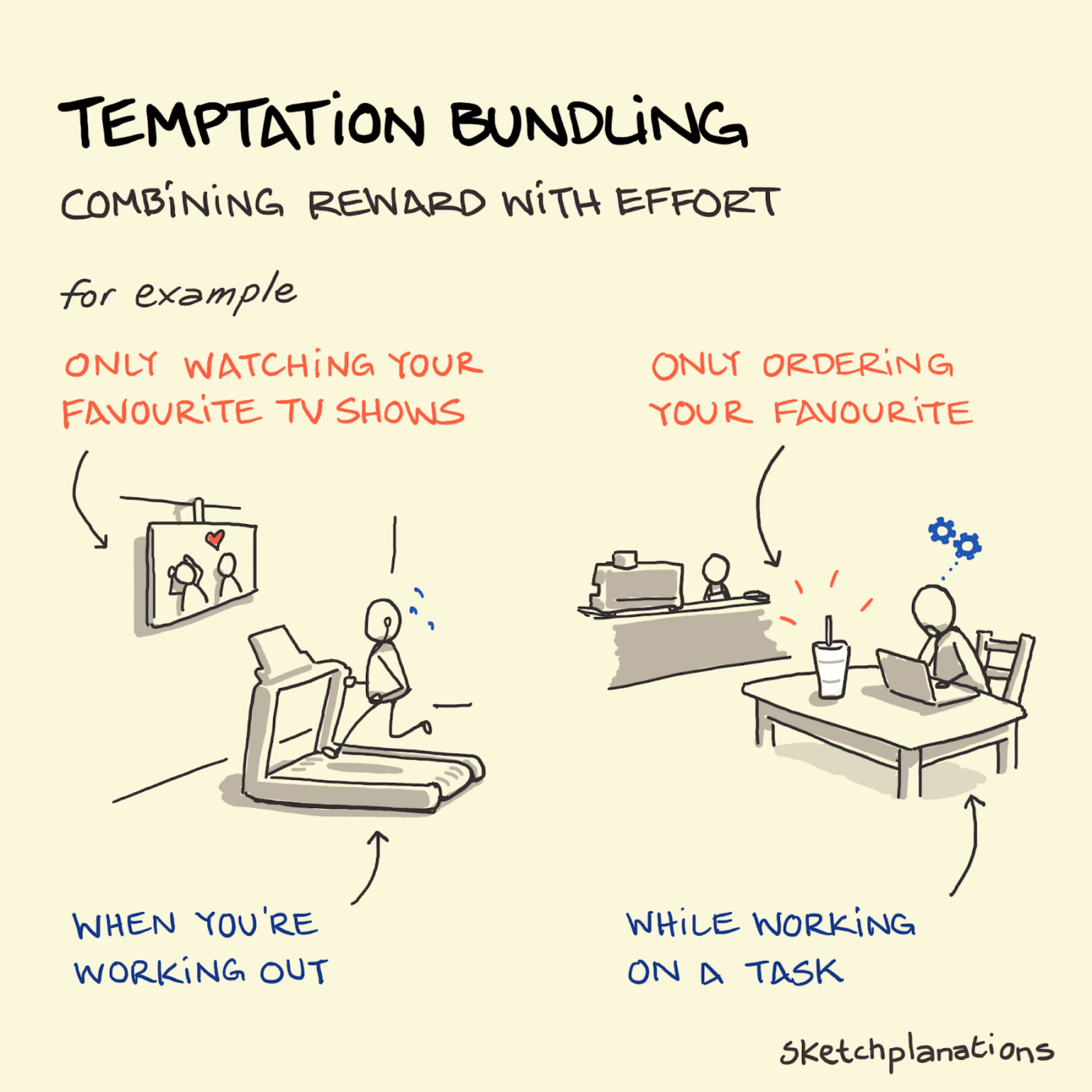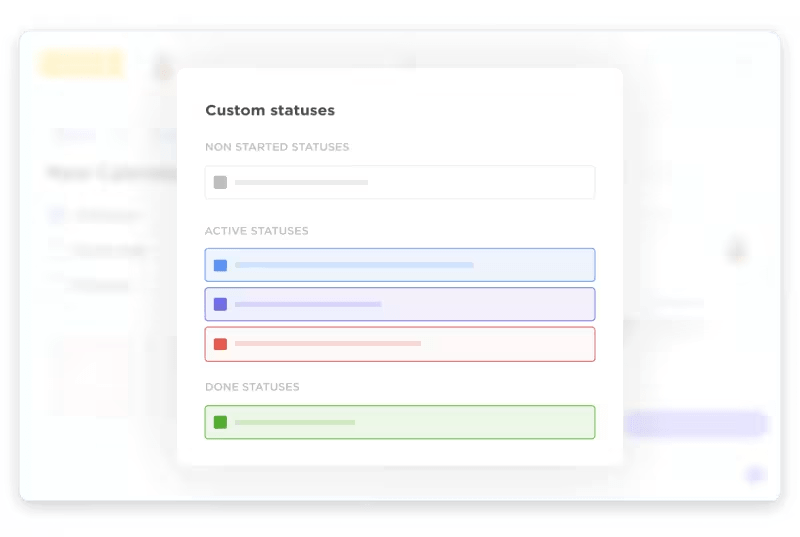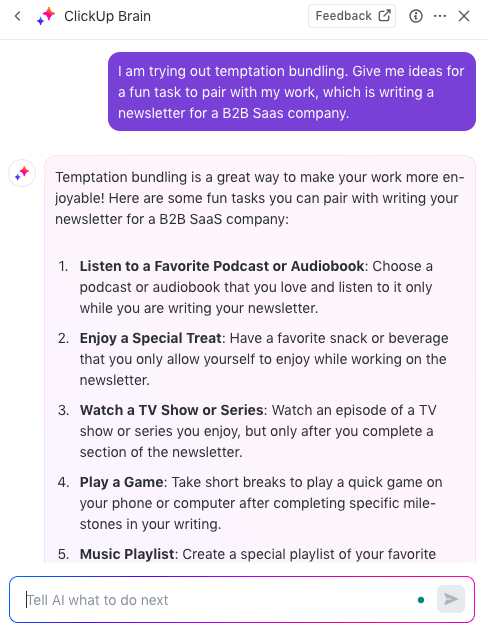How to Use Temptation Bundling to Boost Your Productivity

Sorry, there were no results found for “”
Sorry, there were no results found for “”
Sorry, there were no results found for “”

You know you should be working, but somehow, scrolling through Reels on Instagram is way more appealing. What if there was a way to turn that procrastination on its head and use it to your advantage? A time management game that tricks your brain into making those dreaded tasks feel, dare we say, enjoyable?
Read on to learn all about a smart technique that’ll help you fight procrastination—temptation bundling!

Temptation bundling is the future of productivity. It pairs an activity you like to do with a less enjoyable activity you should do so that the allure of an enjoyable activity (instantly gratifying) motivates you toward achieving your goals.
Here are the key concepts behind this method:
A study revealed that giving the participants audiobooks to encourage temptation bundling boosted their average weekly workouts by 10–12%.
Missing your very favorite restaurant but dreading that Zoom call? Temptation bundling hacks your desires for good! Pair the ‘want’ (restaurant food and ambiance) with the ‘should’ (Zoom call). Now, you only get to visit the cafe when you have those dreaded Zoom calls.
This creates a positive link, making the unpleasant task more digestible. Over time, you might even find yourself answering those calls without heading out to a cafe—a win for self-control and motivation!
The science behind temptation bundling is rooted in behavioral economics, time management strategies, and psychology. The key principles that make temptation bundling effective are:
Temptation bundling helps overcome the tendency to prioritize immediate gratification over long-term goals. Pairing a ‘should’ behavior with a ‘want’ behavior makes the less enjoyable task feel more rewarding in the moment.
Temptation bundling works by creating a sense of self-control and excitement around completing the less enjoyable task, as it becomes the ‘gateway’ to the rewarding activity. This anticipation can increase motivation and make you look forward to the task. Imagine listening to an exciting true crime podcast while folding laundry or doing other household chores. Bet you can’t wait for episode two!
Consistently pairing the less enjoyable task with the enjoyable activity conditions the brain to find the boring task more attractive over time. And this can help turn it into a habit, like snacking while you finish dreaded projects.
Temptation bundling reduces the need for pure willpower by making the less enjoyable task feel more rewarding in the moment rather than relying solely on long-term goals to drive motivation.
Depending on your goals, you can apply temptation bundling at different ‘levels’. Here’s how it works:
The power of a test is crucial to understanding the science behind temptation bundling in a few key ways:
Temptation bundling relies on the individual’s desires and motivations, such as a favorite activity or other guilty pleasures. What someone finds enjoyable can vary greatly. Testing different combinations of ‘want’ and ‘should’ activities via a control group allows researchers and individuals to see which pairings are most effective in boosting productivity or achieving goals.
Scientific studies rely on testing and measuring outcomes in a control group to assess the effectiveness of a technique and its primary outcome. In temptation bundling research, tests would track changes in behavior (e.g., increased exercise frequency) after participants implemented temptation bundling strategies versus delayed rewards.
There’s no one-size-fits-all approach. Testing different temptations in control condition bundles allows individuals to find what works best. For example, someone might find listening to tempting audio enjoyable while studying, while another prefers a silent environment. Testing different ‘want’ activities helps personalize the technique for maximum impact.
Researchers can use tests to explore the psychological mechanisms behind temptation bundling’s effectiveness and its long-term benefits. For example, studies could compare brain activity or self-reported feelings of anticipation or reward before and after using temptation bundling.
The power of testing allows scientists to refine the understanding of temptation bundling, personalize its application, and ultimately strengthen its effectiveness.
Are you tempted enough to try your own temptation bundling strategy? Don’t worry if you just have some habit-tracking apps to be productive. We recommend giving ClickUp a try to conquer procrastination. Here’s how:
Plan your day with workflows that suit your style of working. With 15+ customizable ClickUp Views, you can plan your week, month, year, or more!

ClickUp offers various views, including List, Board, Kanban, Calendar, and Gantt views. Each view presents your tasks differently, allowing you to visualize your temptation bundles from various angles.
ClickUp Views are versatile and can be applied to any number of use cases—from creating effective study schedules to setting (and getting) fitness goals and moving the needle on all sorts of critical projects at work.
Davide Mameli, Business Unit Manager at ICM.S (part of Accenture), says:-
ClickUp Views aren’t just cosmetic. They are a critical and powerful way for us to visually organize and structure work.

For smaller ClickUp Tasks like reviewing notes, emails, or standup reports, create multiple tasks (should do) and pair each with a short, focused, indulgent break (want to do). Use ClickUp’s Project Time Tracking feature to stay on track and review how much time you spend in the day on work vs. leisure.
You can record time spent on each task from your desktop, mobile, or web browser with a Chrome extension.
For longer tasks, consider thematic bundling. If studying a novel for your Literature class, create subtasks for each chapter and pair them with listening to a chapter of a different novel you enjoy. Organize this in a list view and set a time limit for each chapter so that progress is trackable as you continue reading.
For example, if your main task is ‘write a research paper on the history of flights’.
Create subtasks like
Need help with tasks? Ask ClickUp Brain, your built-in AI assistant on ClickUp!
Studying with friends? Use ClickUp to create a shared list and assign tasks with bundled breaks, like watching a funny cat video together after completing a chapter.
Use recurring tasks in ClickUp to schedule your temptation bundles in advance, creating a consistent study routine with built-in breaks.
Simplify your work by setting priority levels for every task. For example, assign a higher priority to your ‘should do’ tasks within the bundle to ensure they get tackled first.
ClickUp has a library of 1000+ pre-built templates, and you can create your own custom templates for specific use cases.
For example, we know that forming a new habit (especially a good one!) is difficult. Why not make it easier by using a habit tracker template? Instead of having to create a mechanism from scratch to track new habits by day, week, or month, such a template does the job for you with a readymade layout to help you attain peak self-discipline.
ClickUp’s Personal Habit Tracker Template makes it easier than ever to:
Don’t struggle with bothersome chores alone. Use task management tools instead. ClickUp’s Simple Task Management Template is a launchpad for daily organization and goal achievement!
This user-friendly template offers a clear structure and built-in instructions, making it perfect for anyone new to task management. Get started with three intuitive views:
The template comes with two pre-set Statuses—‘To Do’ and ‘Done’—for immediate task status reflection. But don’t stop there! Create additional custom statuses to match your specific needs. This level of detail ensures your task management system is as granular (or flexible) as you require
Let’s not forget that ClickUp Brain’s AI tools, combined with other ClickUp features, can help you craft and implement effective temptation bundles. Here’s how it can enhance your productivity:

Based on real-world case studies and examples, let’s examine how people, businesses, and organizations are employing temptation bundling.
There are interesting examples in literature that capture this idea. Here’s how we can see it in the world of Harry Potter:
Headmaster Dumbledore is known for his fondness for lemon drops (sherbet lemon in the U.K. version). Interestingly, he often carries them while delivering difficult or important messages. This could be seen as a way to make these challenging conversations more palatable, bundling the unpleasant news with a small treat.
A popular answer on Quora also seems to support this view.

The concept of temptation bundling isn’t limited to individual productivity. Businesses, too, can leverage their power to influence consumer behavior.
A prime example of this strategy in action is the ‘Thank God It’s Thursday’ (TGIT) programming block launched by the American Broadcasting Company (ABC) during the 2014–15 television season.
ABC’s strategy centered around creating a powerful temptation bundle for viewers. Every Thursday, the network aired a block of three popular shows—Grey’s Anatomy, Scandal, and How to Get Away with Murder, all created by the acclaimed screenwriter Shonda Rhimes. This thematic bundling offered viewers a consistent and engaging experience, catering to their enjoyment of Shonda Rhimes’ work.
ABC didn’t stop at just airing the shows. They actively encouraged viewers to embrace the TGIT experience as a whole. Promotions explicitly mentioned enjoying popcorn and red wine and creating a relaxing Thursday evening ritual alongside the shows. This additional layer of temptation bundling further incentivized viewership by associating the shows with a desirable and enjoyable experience.
The TGIT programming block demonstrates how businesses can leverage temptation bundling to create loyal customer bases. By strategically pairing desired products or services with enjoyable experiences, businesses can foster positive associations and drive consumer engagement.
One real-world example of temptation bundling in action is a system called ‘Cycflix’ created by Ronan Byrne, an engineer in Ireland.
Byrne struggled to stay motivated to exercise regularly on his stationary bike. So, he decided to apply the principles of temptation bundling to create a custom system that would only allow him to watch Netflix if he was actively cycling.
Here’s how Cycflix works:
By pairing his desire to watch Netflix (the want behavior) with the requirement to exercise on the bike (the should behavior), Byrne significantly improved his exercise routine.
In an interview, Byrne reported that the Cycflix system increased his average weekly cycling time from 1 hour to 4–5 hours. He could binge-watch his favorite shows guilt-free, but only while staying active on the bike. This is a clever real-world application of temptation bundling principles.
The Cycflix case study demonstrates how temptation bundling can be customized and implemented creatively to drive positive behavior change. It’s an inspiring example of using behavioral science insights to improve productivity and health.
We all know the feeling—the good intentions to eat healthier, increase exercise, or buckle down and study or work. But willpower is a fickle beast, easily depleted by the daily grind and more immediate temptations. Before we know it, those long-term goals get pushed aside.
Economists offer a solution: commitment devices. These are strategies that ‘lock you in’ to behaviors you might lack the willpower to maintain independently.
A research experiment at the Wharton School demonstrates the combined effect of commitment devices and temptation bundling at a gym. Researchers divided participants into two groups. One group could listen to tempting audio novels (think Hunger Games)—but only while exercising (gym-only access). The excitement of the story proved to be a powerful motivator—this group’s gym visits were 51% more often than the control group!
While the effect faded over time, 61% of the participants in the temptation bundling group opted to keep paying for gym access with audiobooks and iPods.
This highlights the effectiveness of this approach for many people.
Temptation bundling offers a strategic way to overcome limitations and achieve long-term goals. By pairing something enjoyable with a necessary task, we can transform our daily routines.
Temptation bundling emerges as a surprisingly effective weapon in our fight against procrastination. This strategy boosts productivity and injects a dose of enjoyment into our daily routines.
However, temptation bundling isn’t without its quirks. Finding the perfect pairings can be an exercise in trial and error, and their effectiveness can vary depending on the individual. This is where ClickUp steps in with its intuitive task management features, which help you brainstorm, organize, and experiment with different temptation bundles.
Its time tracking keeps you honest, ensuring you dedicate focused effort to the ‘should do’ tasks while keeping your enjoyable breaks in check. Its customizable views allow you to visualize your progress and personalize your workflow, making temptation bundling an engaging and sustainable approach to boosting productivity.
Sign up on ClickUp today and get more out of your day with temptation bundling!
© 2026 ClickUp